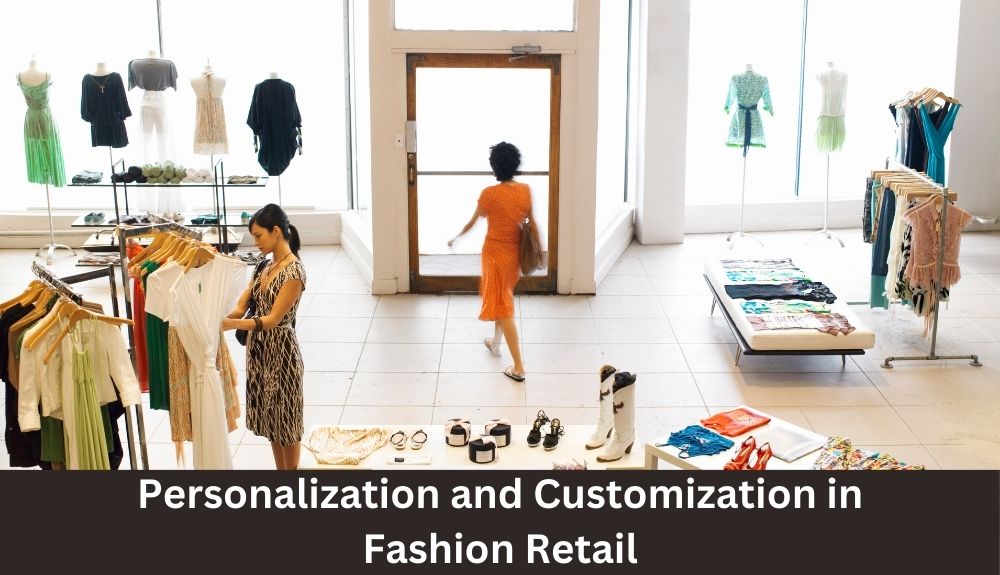The Future of Fashion Retail: Trends and Innovations in Brick-and-Mortar and Online Stores
Welcome to the exciting world of fashion retail, where trends change faster than you can say “runway.” In this ever-evolving industry, staying ahead of the game is key. And with technological advancements and shifting consumer preferences, both brick-and-mortar stores and online platforms are redefining the shopping experience.
Gone are the days when fashionistas had to trek from store to store in search of their next fabulous find. The rise of e-commerce has revolutionized the way we shop for clothing, making it easier than ever to browse a vast array of styles with just a few clicks. But as online shopping becomes increasingly popular, traditional retailers have also been forced to adapt or face extinction.
So what does the future hold for fashion retail? In this blog post, we’ll explore some of the latest trends and innovations that are shaping both online and offline stores. From integrating technology into physical locations to personalization and sustainability initiatives, let’s dive into the fascinating world where style meets innovation!
Advancements in Online Shopping for Fashion
Online shopping has revolutionized the way we shop for fashion. With just a few clicks, you can browse through thousands of products and have them delivered right to your doorstep. But the advancements in online shopping go far beyond convenience.
One major trend is virtual try-on technology. Gone are the days when you had to rely on guesswork to determine if an outfit would look good on you. Now, with virtual try-on tools, you can see exactly how that dress or pair of jeans will fit and flatter your body type before making a purchase.
Another exciting development is augmented reality (AR) shopping experiences. Imagine being able to virtually walk into a store from the comfort of your own home! AR allows you to explore 3D models of clothing items, try different colors and styles, and even mix and match outfits without ever leaving your couch.
Additionally, artificial intelligence (AI) algorithms are transforming the online fashion retail experience by providing personalized recommendations based on your previous purchases and browsing history. These algorithms analyze data points such as style preferences, body measurements, and customer reviews to curate a selection tailored specifically for you.
Furthermore, advancements in logistics have made same-day delivery or even one-hour delivery possible in some areas. This means that if you need an outfit for an event tonight but don’t have time to go out shopping, you can order it online knowing it will arrive in time.
In summary,
The world of online fashion retail continues to evolve at a rapid pace with advancements like virtual try-on technology, augmented reality shopping experiences,and AI-powered personalization becoming increasingly commonplace.
With these innovations,making confident purchasing decisions from the comfort of our own homes has never been easier.
Thanks to improved logistics,you can now receive same-day or even one-hour delivery,giving us more flexibility when it comes to meeting our urgent fashion needs.
It’s clear that as technology continues advancing,the possibilities for enhancing our online shopping experiences are virtually endless.
Integrating Technology into Brick-and-Mortar Stores
In today’s rapidly evolving retail landscape, brick-and-mortar stores are finding innovative ways to integrate technology into their operations. Gone are the days when physical stores were solely focused on in-person transactions. Now, retailers are leveraging technology to enhance the overall shopping experience and stay competitive in an increasingly digital world.
One way technology is being integrated into brick-and-mortar stores is through interactive displays and smart mirrors. These cutting-edge tools allow customers to virtually try on clothes, experiment with different styles and colors, without having to physically change outfits. This not only saves time but also enhances convenience for shoppers.
Furthermore, many retailers are embracing mobile payment options such as digital wallets and contactless payments. By offering these convenient methods of payment, customers can quickly check out without fumbling for cash or credit cards. This seamless process streamlines the shopping experience and reduces transaction times.
Additionally, augmented reality (AR) has gained traction in brick-and-mortar stores by enabling shoppers to visualize how products would look or fit in real life. For example, furniture retailers use AR to show customers how a particular piece of furniture would look like in their homes before making a purchase decision.
Moreover, integration of artificial intelligence (AI) chatbots has become increasingly common among retailers aiming to provide personalized assistance at all times. AI-powered chatbots offer instant customer support by providing product recommendations based on individual preferences or even assisting with sizing inquiries.
Beacon technology is revolutionizing the way retailers engage with customers within physical stores. Beacons use Bluetooth signals to communicate with smartphones and deliver personalized offers or recommendations based on a shopper’s location within the store premises.
By incorporating these technological advancements into their brick-and-mortar locations, fashion retailers can create immersive experiences that blend online convenience with offline interactions – ultimately enhancing customer satisfaction and driving sales.
Personalization and Customization in Fashion Retail

Personalization and customization have become key trends in the fashion retail industry, as consumers increasingly seek unique and individualized experiences. With the rise of technology and data analytics, retailers are now able to offer personalized recommendations based on a customer’s preferences, past purchases, and browsing history.
In online stores, this is often achieved through algorithms that analyze user data to suggest products that match their style or fit. For example, platforms like Amazon use machine learning to recommend clothing items based on a customer’s previous purchases or search history.
Brick-and-mortar stores are also embracing personalization by implementing interactive technologies. Some brands have introduced virtual fitting rooms where customers can try on clothes virtually before making a purchase. Others use smart mirrors that allow shoppers to see how different outfits would look without physically trying them on.
Furthermore, customization has gained popularity as consumers crave unique pieces tailored specifically for them. Many brands now offer customizable options such as monogramming or allowing customers to choose colors and materials for their garments.
This trend extends beyond clothing; accessories like jewelry and footwear can also be personalized with engravings or custom designs. By offering these options, retailers create a sense of exclusivity while meeting the demands of individualistic consumers.
The desire for personalization in fashion retail goes hand in hand with the growing emphasis on self-expression through style choices. Shoppers want their clothing to reflect their personality and values rather than conforming to mass-produced trends.
Sustainability and Ethical Practices in Fashion Retail
In today’s fashion industry, sustainability and ethical practices have become increasingly important factors for consumers. People are now more conscious of the environmental impact and labor conditions associated with their clothing purchases. As a result, fashion retailers are starting to prioritize sustainable materials, responsible sourcing, and fair trade practices.
Many brands are embracing eco-friendly fabrics such as organic cotton, hemp, and recycled polyester. By using these materials in their collections, they reduce the reliance on harmful chemicals and contribute to less waste in landfills. Additionally, some companies focus on reducing water consumption during production processes.
Ethical practices involve ensuring that workers involved in garment manufacturing receive fair wages and work under safe conditions. Retailers are striving to partner with factories that adhere to international standards for labor rights. Transparency is also becoming crucial; customers want to know where their clothes come from and how they were made.
Fashion retailers are taking steps towards implementing sustainable initiatives beyond just product offerings. Some brands offer recycling programs where customers can bring back old garments for proper disposal or reuse them through upcycling projects.
Furthermore, collaborations between ethical fashion brands and social enterprises have emerged as an innovative way to support disadvantaged communities while creating stylish products.
Sustainability and ethical practices have become integral parts of the fashion retail landscape. Consumers’ demand for transparency about supply chains will continue driving positive change within the industry. By adopting environmentally friendly manufacturing processes and ensuring fair treatment of workers throughout the supply chain, fashion retailers can align themselves with consumer values while making a positive impact on both people and the planet.
The Rise of Pop-Up Shops and Experiential Retail

The retail industry is constantly evolving, and one trend that has been gaining momentum in recent years is the rise of pop-up shops and experiential retail. These temporary stores offer a unique and immersive shopping experience for consumers, creating a sense of urgency and exclusivity.
Pop-up shops are all about creating buzz and excitement. They often appear unexpectedly in vacant storefronts or at events, offering limited-time-only products or collaborations with popular brands. This scarcity drives customers to act quickly, fostering a sense of urgency to make a purchase before it’s too late.
Experiential retail takes this concept even further by focusing on creating memorable experiences for shoppers. These stores go beyond just selling products; they aim to engage all the senses through interactive displays, innovative technologies, and curated environments. Customers can try on virtual garments using augmented reality mirrors or participate in hands-on workshops led by industry experts.
By combining the thrill of discovery with an immersive experience, pop-up shops and experiential retail attract not only avid fashion enthusiasts but also curious passersby who may not have otherwise visited traditional brick-and-mortar stores. This trend taps into our desire for unique experiences in every aspect of our lives – including shopping.
In addition to generating hype around their brand or product launches, pop-up shops can also serve as valuable testing grounds for new concepts or locations without committing to long-term leases. Brands can gather feedback from customers firsthand while building relationships with potential buyers.
The rise of pop-up shops and experiential retail showcases how retailers are adapting to changing consumer preferences by providing engaging experiences that cannot be replicated online. By embracing these innovative strategies, fashion brands can create lasting impressions on their customers while driving sales and staying relevant in an increasingly competitive market.
Conclusion: The Importance of Adaptation in the Fashion Industry
In an ever-evolving industry like fashion, adaptation is key to survival. The changing landscape of fashion retail demands that both brick-and-mortar and online stores embrace new trends and innovations to stay relevant and meet the evolving needs of consumers.
Advancements in technology have revolutionized online shopping for fashion, making it easier than ever before for customers to browse and purchase their favorite styles from the comfort of their own homes. From virtual try-on tools to augmented reality experiences, these digital enhancements are shaping the future of online fashion retail.
But let’s not forget about the importance of physical stores. Integrating technology into brick-and-mortar locations has become crucial in providing a seamless omnichannel experience. Interactive displays, smart mirrors, and mobile point-of-sale systems are just a few examples of how retailers are leveraging technology to enhance customer interactions within physical spaces.
Personalization and customization have also become vital aspects of fashion retail. Consumers now seek personalized recommendations tailored to their individual preferences, as well as customizable options that allow them to express their unique style. Retailers who can offer these personalized experiences will undoubtedly set themselves apart from the competition.
Sustainability and ethical practices have emerged as significant considerations for both retailers and consumers alike. With increasing awareness about environmental impact and labor conditions within the industry, brands that prioritize sustainability are gaining favor among conscious shoppers. By adopting sustainable practices throughout their supply chains, retailers can contribute positively towards a more environmentally friendly future.
Another trend taking center stage is the rise of pop-up shops and experiential retail. These temporary installations create excitement through limited availability or exclusive collaborations while offering immersive brand experiences beyond traditional store formats. Pop-up shops provide opportunities for experimentation with innovative concepts while generating buzz around brands or specific collections.
In conclusion, staying ahead in the fast-paced world of fashion requires constant adaptation – whether it’s embracing technological advancements, personalizing customer experiences, prioritizing sustainability efforts or creating memorable brand encounters. The future of fashion retail lies in the ability to blend the best of both.











